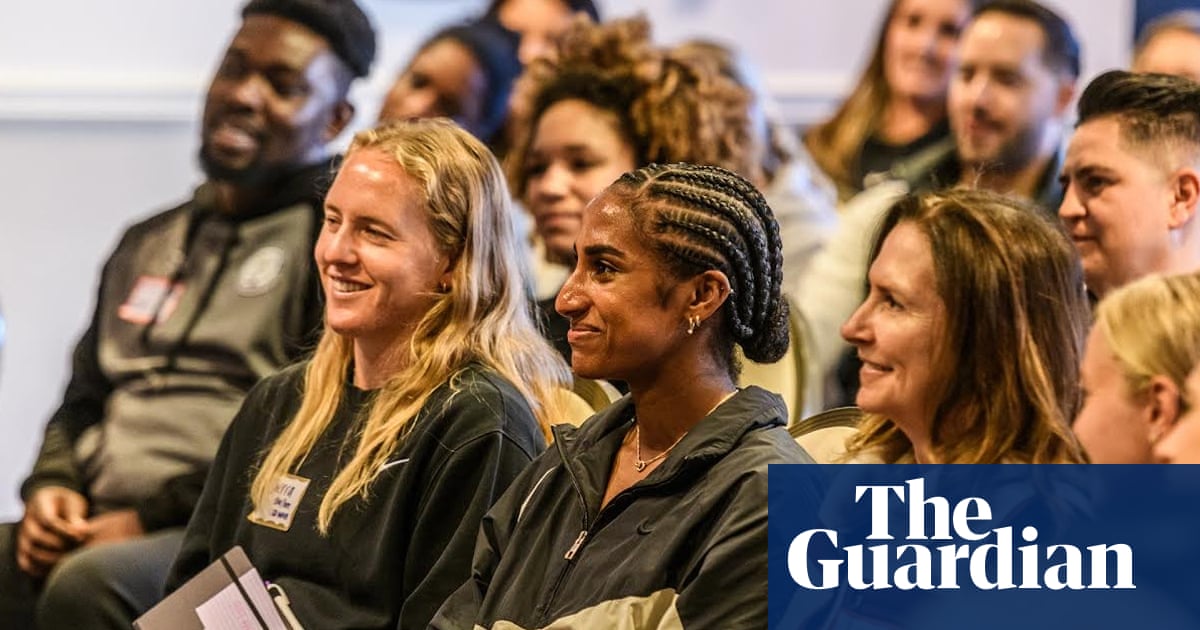
‘People don’t understand how hard breaking is, it’s gymnastics on steroids, it’s crazy, next level,” says David Russell, aka Footloose, as he watches a group of breakers (the proper term for breakdancers) warming up. They’re not in a club, or on a street corner, but in a science lab. Which is the kind of thing that happens when your passion becomes an Olympic sport.
Breaking will feature in the Olympics for the first time at the Paris games in 2024, following other urban sports such as skateboarding. It’s a leap from breaking’s origins in the emerging hip-hop culture of the Bronx in the late 1970s. To get the “Is it sport or is it art?” question out of the way, there’s no reason breaking can’t be both, and as art forms go, competition is built into breaking’s battle format – B-Boys face off against each other with moves including headspins, flares and windmills – and it already has an established international competition circuit.
There’s an increasing professionalisation of the dance form: in 2024 Sadler’s Wells is opening a hip-hop academy at their new theatre in Stratford to train 16- to 19-year-olds; and then there’s new interest from sports scientists, such as Matthew Cole at Birmingham City University, who has teamed up with Russell’s organisation Break Mission to begin compiling data on the physiological attributes of breakers in what he hopes will be a large-scale study. In his lab at BCU, music’s on the stereo, and the dancers are busy testing hamstring and grip strength; someone’s in a motion capture suit, tracking biomechanics; there are metal force plates on the floor, normally used to measure leg strength in jumping. But here dancer Nehemiah Smith, aka NeNe, is upside down hopping on his hands instead.
Some people think this isn’t a sport, I say to him once he’s right-side up again. “I’m not going to lie, I was one of those people,” he says. “Because there’s a real history with breaking, there’s a real culture behind it. But going from the streets to the Olympics, I think it shows it speaks to everyone, which is the real beauty of this culture.”
Twenty-two-year-old Giovanna Fontana, aka B-Girl Solid, is currently Italy’s number two, although she’s based in London, where she trains four-and-a-half hours a day, six days a week. “We train as athletes, but we dance as artists,” she says, emphasising how important creativity is alongside physical attributes. In battles, for example, the dancers don’t know what music the DJ will play, so they have to respond in the moment.
Eager to put himself to the test in the lab is Dawid Baraskiewicz, who until recently was at full-time ballet school, but ditched ballet for breaking, teaching himself in lockdown. “I was sneaking into school when I wasn’t supposed to, going into the studios,” he says. “I was training on carpet, concrete, grass, wherever and whenever I could. Ballet was so limiting. With breaking you do whatever move you want, however you want. It’s complete and utter freedom. It’s amazing.” Baraskiewicz is now on an elite athlete training programme in Wales (and has his sights on an Oxbridge maths degree) but at only 16, he’s looking beyond Paris. “2028, that’s my year,” he smiles.
The competition to get a place at Paris 2024 is exceptionally fierce. There’ll be only 32 dancers worldwide: 16 male, 16 female. Some will qualify by winning regional championships, others by accruing points at accredited events, including the European Championships being held in Manchester this weekend. The breaking scene is strong in the US, as you’d imagine, but also in France, Japan, Korea, China: “There are four-year-olds in China on a ridiculous level!” says Russell. The organisation Breaking GB is supporting a handful of dancers in their push towards Olympic qualification, including Roxanne Milliner, aka B-Girl Roxy. “Roxy’s been one of the most influential female breakers in the world over the last 10 years,” says Breaking GB’s Rob Pountney. “She just oozes charisma and natural talent.”
But the Olympic run-up comes at a tricky time for Milliner, 33. She had a son two years ago and slowed down: “I think I’ve done 10 training sessions since I got pregnant.” She spent much of her pregnancy in a wheelchair having torn her pelvic floor muscle. “He was basically growing on the injury. I was in complete agony,” she says. “There was a point where I thought I was never going to dance again.”
Milliner is not yet back to 100%, but “with almost zero training” she won two major UK competitions. “So if I’ve managed to do that, I owe it to myself to really go for it, I think.” When Milliner started out at 17, there were barely any female breakers in what can be “a very misogynistic scene” she says. But there’s been a flood of B-Girls emerging in the last few years, such as 16-year-old B-Girl 671 from China, who placed second at the World Championships in Seoul last month. “She just came out of nowhere and she’s ridiculous,” says Milliner.
Other UK hopes include Emma “Shortbread” Houston, Karam “Kid Karam” Singh, Sam “Sheku” Phillips, and 27-year-old Sunni Brummitt, who started winning titles as a teenager. Being a good breaker isn’t about having a certain body type or exact skillset, says Brummitt – some dancers are more athletic, others more musical or creative. There’ll be more defined judging criteria at the Olympics than most battles, but still, breaking is “a subjective sport”, he says. Dedication is most important, and Brummitt certainly has that: when he was younger he spent a few years on-and-off sleeping on a dance studio floor in east London so that he could spend all his time practising. Now he trains six hours a day, and he’s known for his agility and originality.
While some breakers are purists, staying true to its New York roots, Brummitt says: “I’m an English boy who started dancing in the 2000s, so I’m trying to reflect that.” Aside from the explosive acrobatics, it’s the dancers’ self-expression that Brummitt thinks will draw new audiences at the Olympics. “In a lot of sports you don’t get to see the personality shine through, but breaking is very personal.” Pountney agrees: “The great thing about breaking is you can win a battle by strategy or execution – it’s a bit like a martial art, about puzzle solving – or you can win it because you’re completely lost in the moment.”
Brummitt hopes the Olympics will be a chance to show people what breaking’s really about. “We’ve still got the stereotype of dancing under bridges, or 10 seconds in a music video doing a headspin,” he says. “Whereas we are putting in the same time and dedication as other sports, with about 10% of the support. The Olympics is the opportunity to start getting recognition.”
Back in the lab, Cole says in the initial tests many of the dancers’ scores are on a par with professionals in other sports, “Showing they are athletes in the truest sense”. With more data, it could theoretically be possible to spot potential champions. “Take Lizzie Yarnold in the skeleton bob,” says Cole. “She went to a talent ID day. She had the characteristics, four years later wins a gold medal.” But Cole is particularly interested in using data to unlock funding for broader initiatives on public health; using breaking to engage disaffected teenagers, for example. “As much as it’s great to have elite sport, the real value of that is if you can impact change in society.”
At Breaking GB, they’re excited to start building an infrastructure of training opportunities and coaching staff across the country, and to make breaking accessible to all, including girls who might have been put off in the past, all without the competition scene becoming “sterile” and losing the connection to music and culture “and the fun”, says Pountney. But the priority has to be Paris 2024. “The impact of having a breaker from the UK qualify for the Olympic Games would be absolutely massive, so the legacy of that is huge,” he says.
For the dancers, it’s time to focus. Milliner still gets nervous going into competition. “It’s a bit like the fear of going on a rollercoaster,” she says. “I’m definitely going to do it, because I love it and it’s a big adrenaline rush. But I’m crapping myself in the queue on the way there.” Milliner uses her nerves to fuel her performance. “The buzz that you get really does it for me,” she says. “I used to be quite lazy in training and then I would go 200% in competition to make up for it. But that’s about to change right now,” she says, thinking like an athlete. “Because I’ve got to be an Olympian.”
The European Breaking Championships is at Belle View Sports Village, Manchester, 5-6 November












